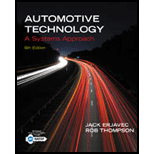
Automotive Technology: A Systems Approach (MindTap Course List)
6th Edition
ISBN: 9781133612315
Author: Jack Erjavec, Rob Thompson
Publisher: Cengage Learning
expand_more
expand_more
format_list_bulleted
Concept explainers
Textbook Question
Chapter 13, Problem 7RQ
True or False? Valve lash is adjusted in many different ways; however, on many OHC engines, the clearance is set by replacing a shim.
Expert Solution & Answer
Want to see the full answer?
Check out a sample textbook solution
Students have asked these similar questions
How does a servo valve work?
what can happen when valve spring tension is too low?
Cam bearings in OHV engines are typically whichtype?a. Split insertb. Full-roundc. Thrustd. None of the above
Chapter 13 Solutions
Automotive Technology: A Systems Approach (MindTap Course List)
Ch. 13 - True or False? Make sure you locate and adhere to...Ch. 13 - How does a torque-to-yield bolt differ from...Ch. 13 - How do seals differ from gaskets?Ch. 13 - Where are thread sealers most often used?Ch. 13 - What are the major differences between aerobic and...Ch. 13 - Which of the following statements is incorrect?...Ch. 13 - True or False? Valve lash is adjusted in many...Ch. 13 - Which of the following statements about the...Ch. 13 - True or False? The computer in most late-model...Ch. 13 - Graphite is. an anaerobic substance an RTV an...
Ch. 13 - Which of the following are considered soft, cut...Ch. 13 - What material is typically not used to form a rear...Ch. 13 - Which of the following statements about preparing...Ch. 13 - On hybrid vehicles, how can you identify the high...Ch. 13 - True or False? Some crankshaft and camshaft timing...Ch. 13 - Prob. 1ASRQCh. 13 - Technician A uses adhesives to hold gaskets in...Ch. 13 - Technician A uses soft gaskets on valve covers....Ch. 13 - Technician A inspects all sealing surfaces for...Ch. 13 - Technician A says that oil pan gaskets are often...Ch. 13 - Prob. 6ASRQCh. 13 - While discussing proper engine break-in:...Ch. 13 - Prob. 8ASRQCh. 13 - Prob. 9ASRQCh. 13 - While selecting the proper RTV for a particular...
Knowledge Booster
Learn more about
Need a deep-dive on the concept behind this application? Look no further. Learn more about this topic, mechanical-engineering and related others by exploring similar questions and additional content below.Similar questions
- True or False? No-start, surging, or stalling can be caused by an EGR valve that does not open.arrow_forwardWhat type of valve lifter automatically compensates for the effects of engine temperature? Hydraulic Solid Roller All of the abovearrow_forwardCam bearings in OHV engines are typically which type? Split insert Full-round Thrust d. None of the abovearrow_forward
- Which of the following is not a type of valve guide seal? Positive Negative Umbrella O-ringarrow_forwardList five problems that can be caused by engine overheating.arrow_forwardTechnician A says an engine may use one or more valve springs per valve. Technician B says additional valve springs are used to control vibration and increase total pressure. Who is correct? a. Technician A b. Technician B c. Both A and B d. Neither A nor Barrow_forward
- Why must hydraulic line pressures increase when there is an increase of load on the engine?arrow_forwardTechnician A says it is not necessary to measure valve stem height unless the valves have been replaced. Technician B says valve stem height can be adjusted with shims. Who is correct? Technician A Technician B Both A and B Neither A nor Barrow_forwardWhich of the following statements about the purpose of a cylinder head gasket is not true? It seals intake stroke vacuum, combustion pressure, and the heat of combustion. It prevents coolant leakage and resists rust, corrosion and, in many cases, meters coolant flow. It allows for lateral and vertical head movement as the engine heats and cools. It meters lubricating oil onto the engines cylinder walls.arrow_forward
- While determining the most likely problem of an engine with poor compression test results but acceptable cylinder leakage readings: Technician A says that the problem may be incorrect valve timing. Technician B says that the problem is worn valve seats. Who is correct? Technician A Technician B Both A and B Neither A nor Barrow_forwardTrue or False? Metering and proportioning valves balance the braking characteristics of disc and drum brakes.arrow_forwardWhat affect shift valves to cause a downshift?arrow_forward
arrow_back_ios
SEE MORE QUESTIONS
arrow_forward_ios
Recommended textbooks for you
 Automotive Technology: A Systems Approach (MindTa...Mechanical EngineeringISBN:9781133612315Author:Jack Erjavec, Rob ThompsonPublisher:Cengage Learning
Automotive Technology: A Systems Approach (MindTa...Mechanical EngineeringISBN:9781133612315Author:Jack Erjavec, Rob ThompsonPublisher:Cengage Learning Refrigeration and Air Conditioning Technology (Mi...Mechanical EngineeringISBN:9781305578296Author:John Tomczyk, Eugene Silberstein, Bill Whitman, Bill JohnsonPublisher:Cengage Learning
Refrigeration and Air Conditioning Technology (Mi...Mechanical EngineeringISBN:9781305578296Author:John Tomczyk, Eugene Silberstein, Bill Whitman, Bill JohnsonPublisher:Cengage Learning Automotive TechnologyMechanical EngineeringISBN:9781337794213Author:ERJAVEC, Jack.Publisher:Cengage,
Automotive TechnologyMechanical EngineeringISBN:9781337794213Author:ERJAVEC, Jack.Publisher:Cengage, Welding: Principles and Applications (MindTap Cou...Mechanical EngineeringISBN:9781305494695Author:Larry JeffusPublisher:Cengage Learning
Welding: Principles and Applications (MindTap Cou...Mechanical EngineeringISBN:9781305494695Author:Larry JeffusPublisher:Cengage Learning

Automotive Technology: A Systems Approach (MindTa...
Mechanical Engineering
ISBN:9781133612315
Author:Jack Erjavec, Rob Thompson
Publisher:Cengage Learning

Refrigeration and Air Conditioning Technology (Mi...
Mechanical Engineering
ISBN:9781305578296
Author:John Tomczyk, Eugene Silberstein, Bill Whitman, Bill Johnson
Publisher:Cengage Learning

Automotive Technology
Mechanical Engineering
ISBN:9781337794213
Author:ERJAVEC, Jack.
Publisher:Cengage,

Welding: Principles and Applications (MindTap Cou...
Mechanical Engineering
ISBN:9781305494695
Author:Larry Jeffus
Publisher:Cengage Learning
Principles of Lubrication | Automobile Engineering; Author: Magic Marks;https://www.youtube.com/watch?v=MGbbSxZTdCQ;License: Standard Youtube License